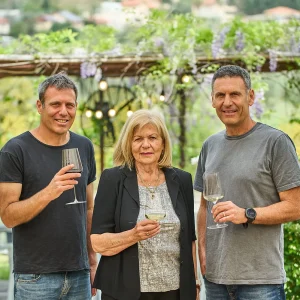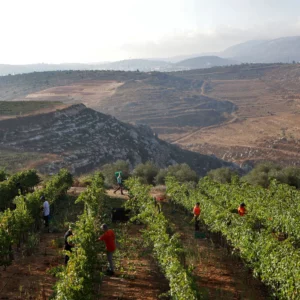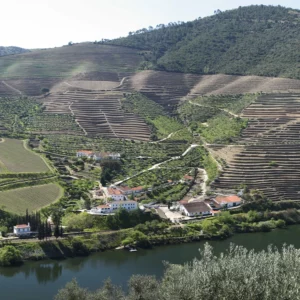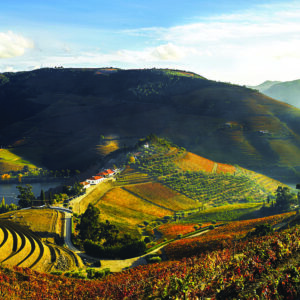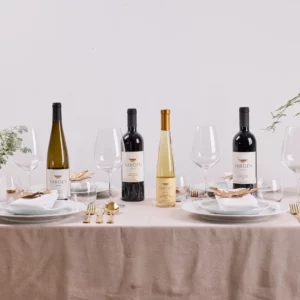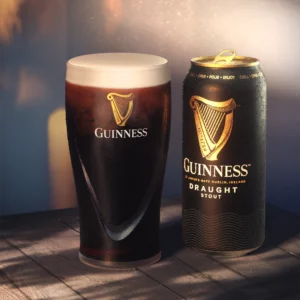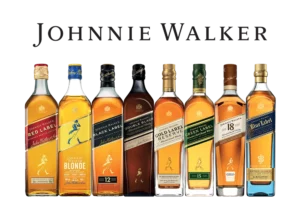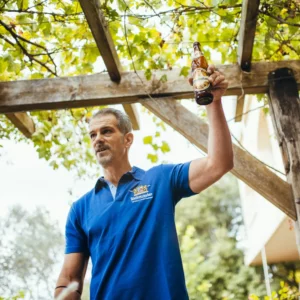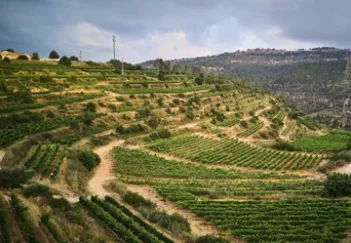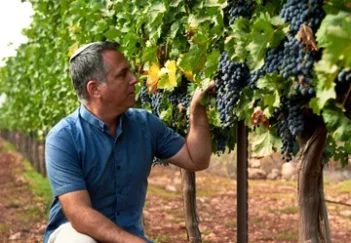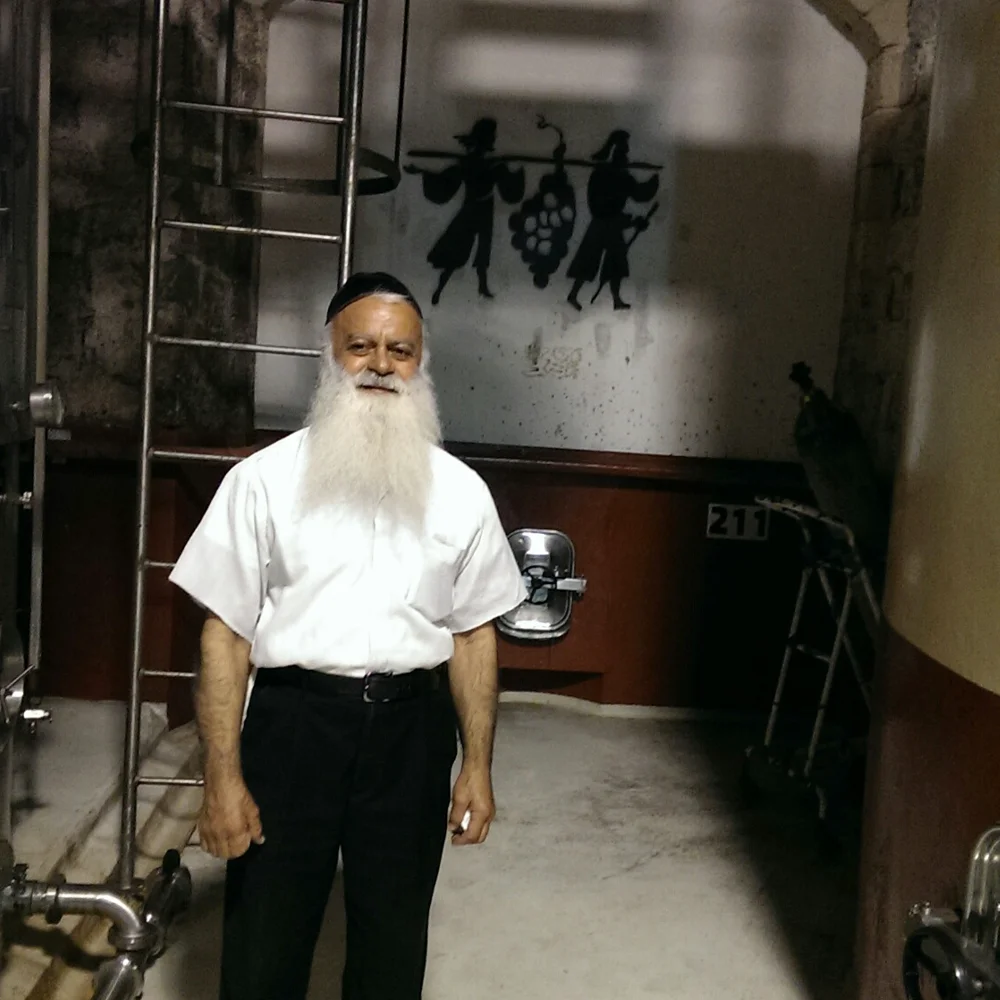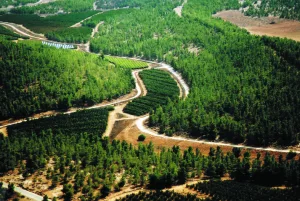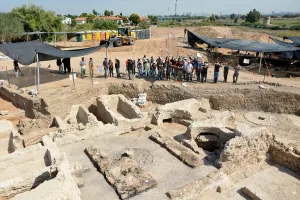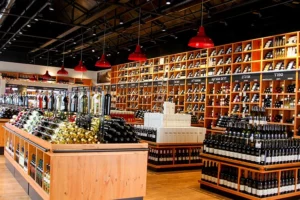The essence of Kashrut in wine may be found in the phrases Yayin Nesech and Stam Yeinam. Both are prohibited to wine drinkers who follow the Jewish Dietary Laws. Yayin Nesech is a wine poured in a libation by idol worshippers. Stam Yeinam is a wine owned, touched or moved by non-Jews. Quite often I am asked if a small winery I have written about is Kosher or not. Often I answer that though it is not, the wine is made by a Jew who is not an idol worshipper. It is meant to be tongue in cheek, but if we are talking tachles, then this sort of winery is not covered by the prohibitions of either Yayin Nesech or Stam Yeinam. In fact Kashrut in wine has been a moveable feast, changing over the years.
In the 19th century there was no Kashrut infrastructure for wine. You just made sure to buy your wine from some neighbor whom you knew to be a good Jew. Wines were sold in small barrels. Glass bottles were scarce and expensive. There were no labels, no kosher stamps or certificates. In 1848 the Shor family founded Zion Winery in the Muslim Quarter of the Old City of Jerusalem. Their winery folklore says families used to send the daughter of the household to the winery to fill the only bottle they had. Why the daughters? Because the adults were working and the boys were studying. When they walked back home they would cover the bottle carefully in cloth so as not to inflame the Arab street because the Muslims were prohibited alcohol and not to do render the wine un-kosher by prying eyes.

In my own family, Sir Moses Montefiore was so religious that he would travel with his own Shochet (ritual slaughterer). He was a wine lover. In common with the trend in Britain at the time, his tipple was Port. However, I often wonder if and how the wine he drank was Kosher. Maybe he arranged for a converso or crypto Jew to make it in Oporto. Alternatively, according to Maimonides, if a spoonful of honey was added to the barrel, this would render the status of the wine as though it had been boiled (Yayin Mevushal). Easy to do and it would not affect the taste. In Britain there was a custom that religious Jews would drink non-kosher brandy, because it was no longer wine. Possibly Port, a wine fortified with brandy, was considered in this category. There was also a certain laxity or flexibility about Stam Yeinam amongst the Rabbis in Italy which lasted from the 16th century to the mid-20th century. Of course, the family came from Italy, and Moses Montefiore was born in Livorno. So, it is possible he followed the Italian rite with regard to wine, but it is a conundrum and I don’t have the answer. However, the story illustrates that the Kashrut interpretation was not monolithic, but differed according to the period, person, place and local customs.
It took to the early 20th century before the kashrut of wine was formalized. Rabbinical involvement started when individual Rabbis would recommend brands to support their meagre salaries. The advent of labels for wines hastened this, allowing a Kosher stamp to be added.

In Israeli wineries, the stringency of Kashrut has changed and in fact has become stricter. In Carmel Mizrahi, the symbol of Kosher wine worldwide for over 100 years, a Jewish but non-religious winemaker would once be able to put on a kippa and go into the winemaking engine room and touch everything without any restriction. Of course the most famous winery worker was none other than David Ben Gurion, who worked in the production part of Rishon Le Zion Cellars in 1907 and he was not religious by any means. The experience did nothing for his appreciation of wine. The smell of the wine during harvest made him feel nauseous and as a result, he could not drink wine for years afterwards.
Things suddenly began to get stricter in the 1980s due to a combination of reasons. The new emphasis on quality dry wine led by the Golan Heights Winery, the rise of Shas as a political entity and the realization that Kashrut supervision was ripe with earning potential resulted in a new competiveness between Kashrut authorities. They became like brands in an overcrowded market place. Everyone would have the certification they would favor, and large wineries started hedging their bets by having a number of hechshers as opposed to just one from the Rabbinate.

I have had different interactions with mashgihim (religious supervisors), illustrating differences of interpretation. I remember once being terribly concerned when a guest visitor to the winery brushed against a barrel, only to be reassured by the religious supervisor, not to worry. If the wine does not actually move, it is not an issue. On another occasion I remember an assistant religious supervisor bellowing and screaming at an important VIP guest when he thought he was about to touch a barrel. It was as though the wrath of G-d himself was among us! The most famous example of wine being disqualified from being Kosher was at Carmel’s Zichron Ya’acov Cellars in 1995. Yair Margalit took the wine and the Chardonnay became very well known as Margalit Winery’s first white wine, which was sold as a non-Kosher wine. Of course these issues happened at every winery, but the most of the juicy stories can’t be told.
If Kashrut seems stricter in the Holy Land, the situation in Europe seems easier going. Once a Kosher batch made in a non-kosher winery was separated by tarpaulins and padlocks, and without the mashgiach, you could not get near it. Today the tanks and barrels holding Kosher wine lie alongside those holding non-Kosher wine. The only way to identify them is by the masking tape, put on in an amateurish Heath Robinson way, over the tap or bung.
Of course it was not just Kashrut in wine that has become stricter in Israel, every part of the religion has. This was part of the reason Tzohar was founded in 1995 by Rabbi David Stav, Chief Rabbi of Shoham, after the assassination of Prime Minister Rabin. The intention was to offer a religious outlet to Israelis with no political presence or government connection. Rabbi Stav has said that Tzohar is not to make people more observant, but to expose people to the beauty of Judaism. They have done praiseworthy and effective work by making life cycle ceremonies like weddings, funerals and Barmitzvahs more friendly and welcoming, though always following Jewish law.

The next step was that they entered the Kashrut business. The Kashrut branch of Tzohar was developed in 2018 to firmly uphold Halacha in ways that will help more people to observe Jewish tradition and embrace their Jewish identities. As they say “Our strong belief is that religious practice must not be a reason for division in Israeli society.” Amen to that! They have brought non-Kosher businesses into the fold and supported those that feel disenfranchised and cynical about the regular Kashrut channels.
No doubt, Tzohar do a very important job in Israel. Their Rabbis are Torah scholars and orthodox without concession to modernity. They attempt to fill the schism between religious and non-religious Jews by making Judaism more accessible for Israelis. I recently met Rabbi Emanuel Guedj, the CEO of Kashrut Tzohar and Rabbi Elad Moshe, the Rabbi of the Tzohar Kashrut Department. They were so interesting and informative with a positive attitude of trying to help, rather than preferring to slap down. Inclusive instead of being exclusive, and seeing the glass as half full rather than half empty. They avoid name calling at all costs, no matter what mud is thrown at them by those who should know better. I left the meeting encouraged and impressed.
What is a Kosher wine according to Tzohar? Firstly they follow the agricultural laws to the letter. The practices of Orla, Kilai Hakerem, Shmittah and Trumot & Ma’aserot are followed. These may be described as the oldest codified wine laws. Furthermore, only Kosher ingredients may be used in the winemaking process. All these requirements are followed meticulously by Tzohar.
Where there is a bump in the road is in the area of Sabbath observance. The handling of the wine and machinery in most Kosher wineries has to be done only by Sabbath observant Jews. Originally it was decreed that if a non-Jew came in contact with the wine, then it should be regarded as non-Kosher. Over the years this restriction was extended to include non-observant Jews too. Tzohar believe the original Halacha was correct. It was intended to create separation (between Jews and non-Jews), not division (between Jews).
For its compass, Tzohar goes back to the Sages, the Shulhan Aruch and Rav Kook. Their ruling does enable small wineries without the finances to go Kosher and to receive a Tzohar Certificate. Some of the wineries certified by Tzohar are Kerem Barak, Family Baum, Hayogev, Livne, Mika, Roglit, Sde Boker, Scoria, Tzoof and Terra Uma. In total there are 25 wineries in the program.
Rabbi Yisrael Samet, of the Tzohar Rabbinical Council, has said: “Ensuring proper Kashrut is a complex effort requiring deep insight into Halacha and utmost respect for our traditions – and we have never wavered from that commitment, nor do we shy away from full transparency.”
Snow R. Shai is a talented and provocative filmmaker. His film “Holy Wine” addressed the issues of Kashrut in Israeli wine as a mirror of Israeli society. I paraphrase the statements of the two stars of the film, Eli Ben-Zaken of Domaine du Castel and Yair Margalit. Ben-Zaken explained he decided to make his wine Kosher because he wanted all of the Jewish people to be able enjoy his wine, but later added that when he is forbidden to take a sample of his own wine, it makes him feel like a second hand Jew. Margalit decried the caste system (I can’t remember his exact words) that made him an inferior Jew. Just for the record, he produces non-kosher wines, but he is Jewish and not an idol worshipper. There is a certain disconnect that Margalit would be welcomed as a Jew to make up a minyan and can receive an Aliyah in Shul, but as a winemaker he is not Jewish enough.
Tzohar is a valuable addition to spectrum of Kashrut supervision. They should be supported and encouraged. Of course, it is a free world. You follow the hechsher that is valid for you. Simon S. Jacob is creator and host of the wonderful Kosher Terroir Podcast. In a recent episode he interviewed Rabbi Yehoshua Grunstein about Tzohar’s attitude to winemaking. The discussion delves into questions about Jewish identity, inclusion and the purpose of religious authority. Anyone skeptical or wants to learn more, should listen (www.thekosherterroir.com). Jacob is orthodox, a wine macher and maven, whom I respect greatly. I asked him, does he regard the Tzohar wineries as Kosher and would he drink their wine? He answered, “I am tired of all the division. I love what Tzohar are doing. In the spirit of Shalom Bayit, and especially after 7.10, the answer is yes and yes.” If we ever reach the nirvana of “Live and let live”, we will have come a long way.
Adam Montefiore is a wine trade veteran and winery insider turned wine writer, who has advanced Israeli wines for 38 years. He is referred to as the English voice of Israeli wine and is the Wine Writer for the Jerusalem Post. www.adammontefiore.com


